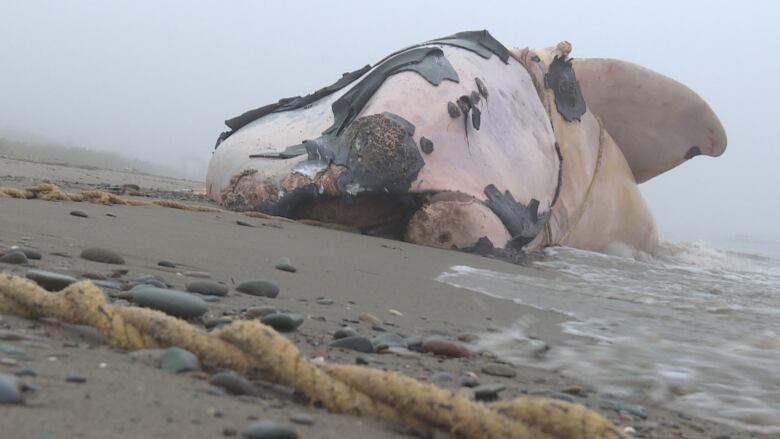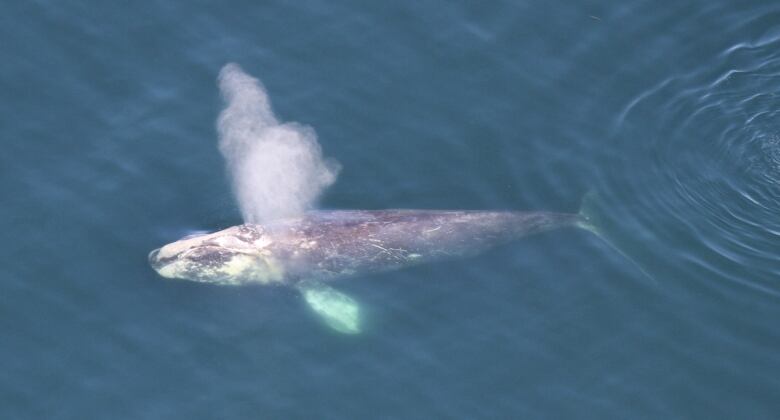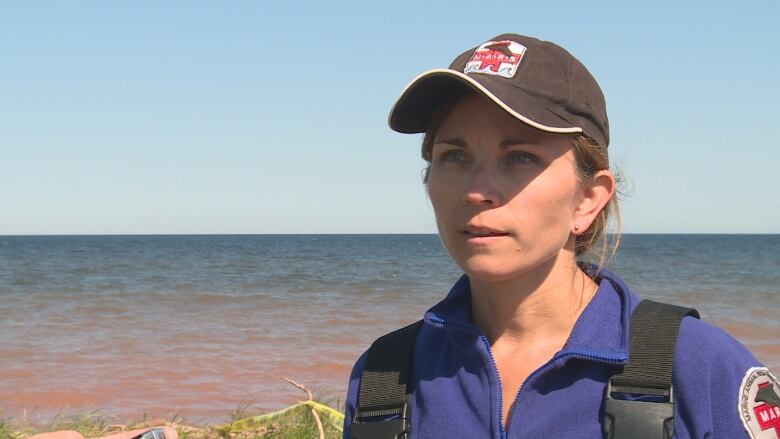Blunt-force trauma, entanglement blamed in deaths of 7 right whales
15 endangered right whales have been found dead off the East Coast of Canada and the U.S. this year

Necropsies on sevenNorth Atlantic right whales founddead in the Gulf of St. Lawrence this summershow that four died of blunt force trauma from collisions with ships, whiletwo appeared to dieafter being entangled in fishing gear. The cause of death for one whale was inconclusive.
Pierre-Yves Daoust, a pathologist and professor at the Atlantic Veterinary College (AVC), and milie L. Couture, a veterinarian with the Zoo de Granby and the Universit de Montral, made their findings public at the Atlantic Veterinary College this morning. Both are part of the Canadian Wildlife Health Cooperative.

The team released a report today outlining what killed six of the whales. The findings in the death of the seventh whale are not yet complete, but team says there are signs that the whale was entangled.
Determining cause of death achallenge
Daoust said it was very challenging to determine exactly how the whales died because they decompose so quickly.
Even determining that the whales were killed by blunt forcetrauma caused by ships was difficult, he said.Thethick blubber and muscle on a right whale makes it hard to detect the injuries;only by examining damage to the whales' organs was the team able to conclude that a blunt force was responsible.

"But because of the major impact there can be shearing of some of the internal organs like liver, like heart, major blood vessels which cause sever internal hemorrhaging, severe internal bleeding which is what we think we saw," said Daoust.
It's likely most of these whales died in different areas and weren't part of the same pod.
Human activity to blame
Out of the seven whales that were examined, five were males and two were females. The entire right whale population is estimated to only consist of about 500 members, so any early deaths have a big impact on the species.
"The fact remains that human activities are a very important cause of this mortality this summer," said Daoust.

A total of 15 endangered right whales have been found dead off the East Coast of Canada and the U.S. this year. Twelvewere found in Canadian waters, while three were off the U.S. coast. The whales ranged in age from two to 37 years old.
"This makes this pretty much the deadliest year we've seen since the days of whaling," said Tonya Wimmer director of the Marine Animal Response Society.
Ship slow zone could move
All those deaths led Transport Canada to introduce a mandatory 10-knot speed limit for large vessels in the Gulf to try and cut down on the number of deaths.Transport Canada now says it will look at removing that slow-down zone once the right whales begin to migrate south.

However, if the whales are spotted in other areas, the 10-knot speed limit will then go into effect there. There is no indication that the whales have started their migration yet.
Daoust said it is impossible to tell through a necropsy what kind of vessel killed a whale or how fast the shipwas movingwhen the marine mammal was struck.
No obvious solutions
It's not clear what course of action should be taken to further protect the right whale.
Wimmersaid everyone needs to come together to save the species. She believes an international working group should be formed to tackle the problem. Such agroup would include members from the Canadian government, the U.S. government, scientistsand the fishing industry.
"We're shifting focus towards what we can do as next steps, how we can go about preventing future mortalities going forward and those discussions are going to be taking place over the coming months,"said Matthew Hardy a division manager with the Department of Fisheries and Oceans Canada.
Deep trouble: Right whales in peril
- 7 right whales entangled this summer, new data shows
- Right whale skeleton, DNA headed to Canada's largest museum
- Snow crab fishery to keep 'sustainable' label amid endangered whale deaths
- Citizen scientists track humpback health 1 photo at a time
- Uncertain future of the North Atlantic right whale linked to its tiny prey
- What's killing right whales? P.E.I. wildlife pathologists spend summer searching for answers
- The story of whale rescuer Joe Howlett's death
- Right whale rescuers wary in wake of death, anxious for work to resume
- Disappearance of right whales from winter breeding grounds a mystery for scientists












_(720p).jpg)


 OFFICIAL HD MUSIC VIDEO.jpg)
.jpg)



























































































